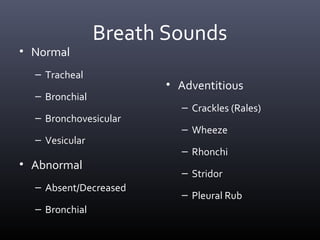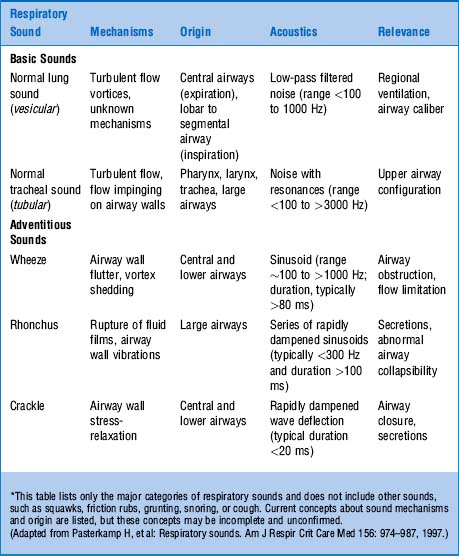This occurs when you exhale. The patterns of normal breath sounds are created by the effect of body structures on air moving through airways.

Normal Breath Sounds Download Table
Duration how long the sound lasts intensity how loud the sound is pitch how high or low the sound.

. Auscultation of lungs help determine the airway and alveolar integrity ventilation and presence of abnormality. Posterior bn scapulae more on right side. In addition to their location breath sounds are described by.
Heard primarily over the lung parenchyma 4. The apex or on the right vs. High pitched as compared with tracheal breath sounds.
What term best describes a louder version of a vesicular sound that can be heard over lung consolidation. This is the most commonly heard breath sound associated with asthma. High pitched as compared with tracheal breath sounds.
Normal Breath Sounds Vesicular Sounds edit edit source The intensity and quality of breath sounds depends on the site of Auscultation. I think its better to change expressions rather than use the smae unique ones. This is the sound of air sacs alveoli popping open.
Which of the following characteristics does not apply to normal tracheal breath sounds. These may be easily audible or identified through auscultation of the respiratory system through the lung fields with a stethoscope as well as from the spectral characteristics of lung sounds. Normal breath sounds are classified as tracheal bronchial bronchovesicular and vesicular sounds.
The 4 most common are. When air sacs alveoli collapse. There are two normal breath sounds.
Tubular cavernous and amphoric. Sounds produced in the large airways have some of their energy content attenuated and filtered during conduction through pulmonary tissue so that only a narrow range of frequencies. Which of the following descriptions applies to normal vesicular breath sounds.
10 rows Normal Breath Sounds Kozier 613 Type Description Location Characteristics Vesicular. Abnormals on a respiratory exam may include. Breath sounds also called lung sounds are the noises that the structures in the lungs make when a person breathes in and out.
I mean like in this case not every breath is the same it would be rather weird if your discription of someones breathing after s would be the same than after climbing a stairs for instance. The only place where. If you are searching for an onomatopoeic word for the sound of regular breathing I did find susurration.
Its usually heard for just a split second when you first start inhaling. The normal sounds that people make when they breathe should hardly. An increase in minute ventilation without reference to.
Anterior upper sternum in 1st and 2nd intercostals spaces. Small clicking bubbling or rattling sounds in the lungs. They are heard when a person breathes in inhales.
Rhonchi a low-pitched breath sound crackles a high-pitched breath sound wheezing a high-pitched whistling sound caused by narrowing of the bronchial tubes stridor a harsh vibratory sound. Sounds that resemble snoring. While you wont use all of these elements in documenting an abnormal respiratory exam these are some of the abnormal physical findings you may need to note.
-Bronchial - high pitch loud inspiration expiration harsh hollow tubular trachea. While not all asthmatics wheeze the majority do. Breath sounds are classified into normal tracheal sound normal lung sound or vesicular breath sounds and bronchial breath sound.
There is also the technical term for normal breathing which is eupnoea. Wheeze-like sound heard when a. What term is used to describe the normal breath sounds heard around the sternum on the anterior chest and between the scapulae on the posterior chest.
The term adventitious breath sounds refers to extra or additional sounds that are heard over normal breath sounds. You may note for example abnormal lung sounds at the lung bases vs. Lung sounds also called breath sounds can be auscultated across the anterior and posterior chest walls with a stethoscope.
It may also be caused by atelectasis or pneumonia. Its impossible to use something that no one has ever used before. Heart sounds s1 s2 apical sounds s1s2 Bowel sounds positive borborygmous positive borborygmous sounds over RLQ.
Wheezing is generally a higher-pitched whistling sound that occurs most commonly when you breathe out. Which of the following terms is used to describe the normal breath sounds heard around the sternum on the anterior chest and between the scapulae on the posterior chest. Respiratory sounds also known as lung sounds or breath sounds refer to the specific sounds generated by the movement of air through the respiratory system.
Bronchial breath sounds are further subdivided into three types. The left side of the chest. Adventitious lung sounds are referenced as crackles rales wheezes rhonchi stridor and pleural rubs as well as voiced sounds that include egophony bronchophony and whispered pectoriloquy.
List and describe 3 types of normal breath sounds. High pitched as compared with tracheal breath sounds. Normal breathing eupniec patient is eupniec.
They occur when air is blocked or air flow becomes rough through the large. This happens when the airways are narrowed due to bronchospasm andor inflammation. Heard primarily during inhalation 3.
Its usually heard in the bases or lower lung fields. Pain or unpleasantness on increased respiratory effort sometimes used interchangeable with breathlessness. The sounds should be soft and muffled 2.
I have physical assessment on Thursday and we have to be descriptive and detailed as well. Bronchial and vesicular Breath sounds heard over the tracheobronchial tree are called bronchial breathing and breath sounds heard over the lung tissue are called vesicular breathing. Sources differ as to the classification and nomenclature of these sounds but most examiners commonly use the following terms to describe adventitious breath sounds.
It is a noun mostly used for a low indistinct whispering sound. Feb 2 2005. However the word breathing itself would seem to be descriptive enough for most usages.
Its a common lung sound in COPD.


0 Comments